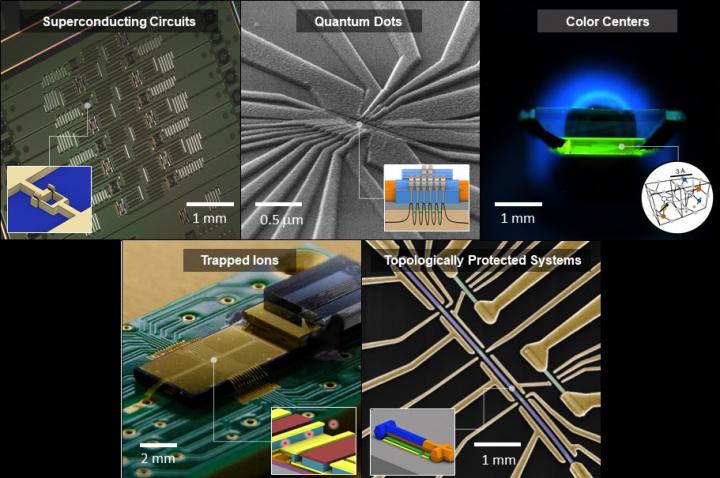Study explores challenges and opportunities for developing the information machines of the future

Credit: Hanhee Paik, IBM
A new study outlines the need for materials advances in the hardware that goes into making quantum computers if these futuristic devices are to surpass the abilities of the computers we use today.
The study, published in the journal Science by an international team, surveyed the state of research on quantum computing hardware with the goal of illustrating the challenges and opportunities facing scientists and engineers.
While conventional computers encode “bits” of information as ones and zeroes, quantum computers breeze past this binary arrangement by creating “qubits,” which can be complex, continuous quantities. Storing and manipulating information in this exotic form – and ultimately reaching “quantum advantage” where quantum computers do things that conventional computers cannot – requires sophisticated control of the underlying materials.
“There has been an explosion in developing quantum technologies over the last 20 years,” said Nathalie de Leon, assistant professor of electrical and computer engineering at Princeton University and the lead author of the paper, “culminating in current efforts to show quantum advantage for a variety of tasks, from computing and simulation to networking and sensing.”
Until recently, most of this work has aimed to demonstrate proof-of-principle quantum devices and processors, de Leon said, but now the field is poised to address real-world challenges.
“Just as classical computing hardware became an enormous field in materials science and engineering in the last century, I think the quantum technologies field is now ripe for a new approach, where materials scientists, chemists, device engineers and other scientists and engineers can productively bring their expertise to bear on the problem.”
The paper is a call to scientists who study materials to turn to the challenge of developing hardware for quantum computing, said Hanhee Paik, corresponding author and a research staff member at IBM Quantum.
“The progress in quantum computing technologies has been accelerating in recent years both in research and industry,” Paik said. “To continue moving forward in the next decade, we will need advances in materials and fabrication technologies for quantum computing hardware — in a similar way to how classical computing progressed in microprocessor scaling. Breakthroughs do not happen overnight, and we hope more people in the materials community will begin to work on quantum computing technology. Our paper was written to give the materials community a comprehensive overview of where we are in materials development in quantum computing with expert opinions from the field.”
At the heart of quantum computers are qubits, which work together to churn out results.
These qubits can be made in various ways, with the leading technologies being superconducting qubits, qubits made from trapping ions with light, qubits made from the silicon materials found in today’s computers, qubits captured in “color centers” in high-purity diamonds, and topologically protected qubits represented in exotic subatomic particles. The paper analyzed the chief technological challenges associated with each of these materials and proposes strategies for tackling these problems.
Researchers hope that one or more of these platforms will eventually progress to the stage where quantum computing can solve problems that today’s machines find impossible, such as modeling the behaviors of molecules and providing secure electronic encryption.
“I think [this paper] is the first time that this kind of comprehensive picture has been assembled. We prioritized ‘showing our work,’ and explaining the reasoning behind the received wisdom for each hardware platform,” de Leon said. “Our hope is that this approach will make it possible for new entrants to the field to find ways to make a big contribution.”
The ten co-authors come from research institutions around the world as well as IBM T. J. Watson Research Center, which has a major quantum computing research group. The scientists met during a symposium on materials for quantum computing sponsored by IBM Quantum and the Kavli Foundation and held at the Materials Research Society Fall Meeting in 2019. They then spent much of their time during the pandemic’s stay-at-home period last year developing this review paper.
“It was a great experience to work with a group with such diverse expertise, and a lot of our activity involved asking each other tough questions about why we believed the things we did about our respective material platforms,” said de Leon, whose research exploits flaws in diamond materials to enable communication between nodes in a future quantum internet.
###
De Leon leads the materials thrust of the new Co-Design Center for Quantum Advantage (C2QA), in which Princeton plays a major role. Funded by the U.S. Department of Energy, the center aims to develop quantum information systems and the quantum workforce that will be needed to design and build these machines.
Support for this project comes from the National Science Foundation (NSF), the Army Research Laboratory’s Center for Distributed Quantum Information, the Horizon 2020 Framework Programme Quantum Internet Alliance, the Austrian Science Fund, the Samsung Science and Technology Foundation, the National Research Foundation of Korea, the Creative Pioneering Researchers Program through Seoul National University, the Institute for Quantum Matter under DOE Energy Frontier Research Center, the QNEXT DOE National Quantum Information Science Research Centers, the NSF-sponsored Penn State Two-Dimensional Crystal Consortium-Materials Innovation Platform, the Program Management Unit for Human Resources Institutional Development Research and Innovation, and an ETH Zürich postdoctoral fellowship.
Media Contact
Catherine Zandonella
[email protected]
Related Journal Article
http://dx.




